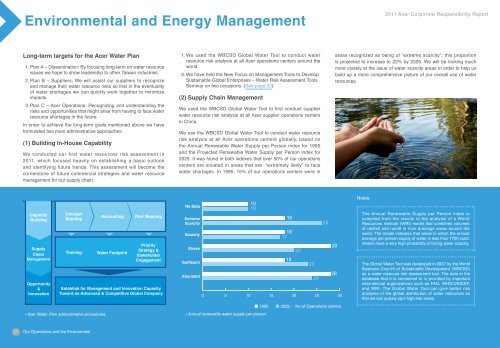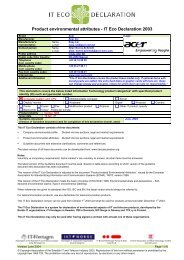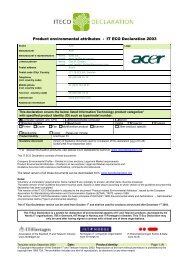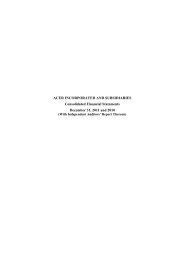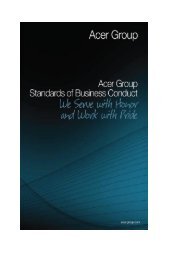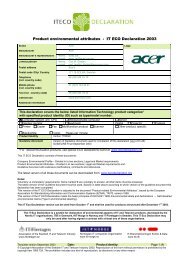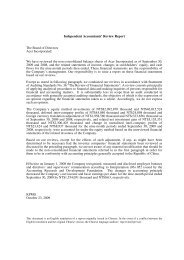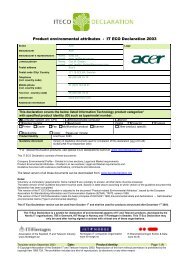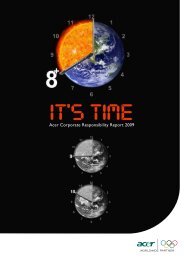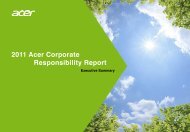2011 Acer Corporate Responsibility Report - Acer Group
2011 Acer Corporate Responsibility Report - Acer Group
2011 Acer Corporate Responsibility Report - Acer Group
You also want an ePaper? Increase the reach of your titles
YUMPU automatically turns print PDFs into web optimized ePapers that Google loves.
Environmental and Energy Management<br />
Long-term targets for the <strong>Acer</strong> Water Plan<br />
1. Plan A – Dissemination: By focusing long-term on water resource<br />
issues we hope to show leadership to other Taiwan industries.<br />
2. Plan B – Suppliers: We will assist our suppliers to recognize<br />
and manage their water resource risks so that in the eventuality<br />
of water shortages we can quickly work together to minimize<br />
impacts.<br />
3. Plan C – <strong>Acer</strong> Operations: Recognizing and understanding the<br />
risks and opportunities that might arise from having to face water<br />
resource shortages in the future.<br />
In order to achieve the long-term goals mentioned above we have<br />
formulated two main administrative approaches:<br />
(1) Building In-House Capability<br />
We conducted our first water resources risk assessment in<br />
<strong>2011</strong>, which focused heavily on establishing a basic outlook<br />
and identifying future trends. This assessment will become the<br />
cornerstone of future commercial strategies and water resource<br />
management for our supply chain.<br />
Capacity<br />
Building<br />
Supply<br />
Chain<br />
Management<br />
Opportunity<br />
&<br />
Innovation<br />
Concept<br />
Building<br />
Training<br />
• <strong>Acer</strong> Water Plan administrative procedures.<br />
25<br />
Our Operations and the Environment<br />
Accounting Risk Mapping<br />
Water Footprint<br />
Priority<br />
Strategy &<br />
Stakeholder<br />
Engagement<br />
Establish for Management and Innovation Capacity<br />
Toward an Advanced & Competitive Global Company<br />
1. We used the WBCSD Global Water Tool to conduct water<br />
resource risk analysis at all <strong>Acer</strong> operations centers around the<br />
world.<br />
2. We have held the New Focus on Management Tools to Develop<br />
Sustainable Global Enterprises – Water Risk Assessment Tools<br />
Seminar on two occasions. (See page 22)<br />
(2) Supply Chain Management<br />
We used the WBCSD Global Water Tool to first conduct supplier<br />
water resource risk analysis at all <strong>Acer</strong> supplier operations centers<br />
in China.<br />
We use the WBCSD Global Water Tool to conduct water resource<br />
risk analysis at all <strong>Acer</strong> operations centers globally, based on<br />
the Annual Renewable Water Supply per Person index for 1995<br />
and the Projected Renewable Water Supply per Person index for<br />
2025. It was found in both indexes that over 50% of our operations<br />
centers are situated in areas that are “extremely likely” to face<br />
water shortages. In 1995, 15% of our operations centers were in<br />
No Data<br />
Extreme<br />
Scarcity<br />
Scarcity<br />
Stress<br />
Sufficient<br />
Abundant<br />
10<br />
10<br />
0 5 10 15 20 25 30<br />
• Annual renewable water supply per person.<br />
18<br />
18<br />
17<br />
18<br />
20<br />
23<br />
24<br />
26<br />
28<br />
28<br />
■ 1995 ■ 2025 No.of Operations centers<br />
Notes:<br />
<strong>2011</strong> <strong>Acer</strong> <strong>Corporate</strong> <strong>Responsibility</strong> <strong>Report</strong><br />
areas recognized as being of “extreme scarcity”; this proportion<br />
is projected to increase to 22% by 2025. We will be looking much<br />
more closely at the issue of water scarcity areas in order to help us<br />
build up a more comprehensive picture of our overall use of water<br />
resources.<br />
The Annual Renewable Supply per Person index is<br />
compiled from the results of the analysis of a World<br />
Resources Institute (WRI) model that combines volumes<br />
of rainfall and runoff in river drainage areas around the<br />
world. The model indicates that areas in which the annual<br />
average per person supply of water is less than 1700 cubic<br />
meters have a very high probability of facing water scarcity.<br />
The Global Water Tool was developed in 2007 by the World<br />
Business Council of Sustainable Development (WBCSD)<br />
as a water resource risk assessment tool. The data in the<br />
database that it is connected to is provided by important<br />
international organizations such as FAO, WHO/UNICEF,<br />
and WRI. The Global Water Tool can give better risk<br />
analyses of the global distribution of water resources so<br />
that we can quickly spot high-risk areas.


